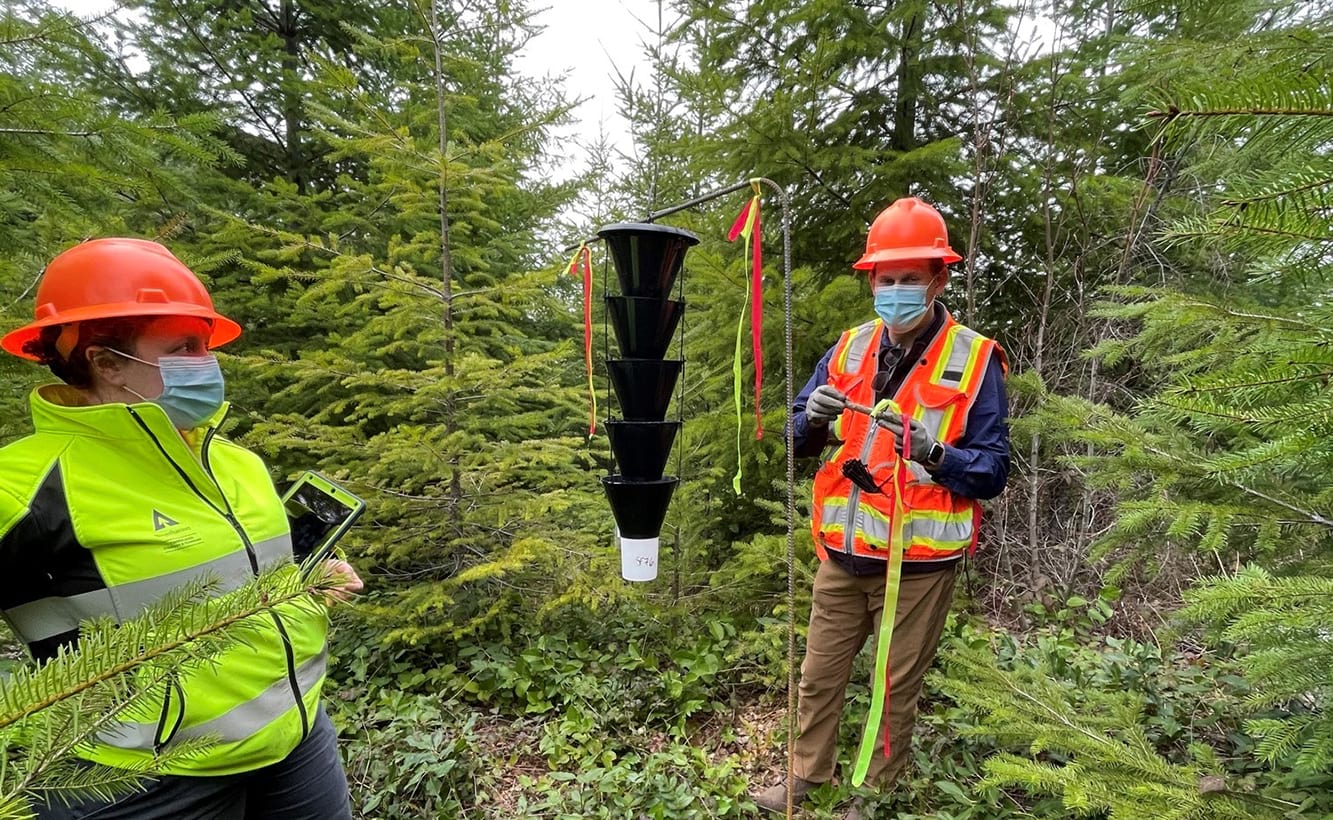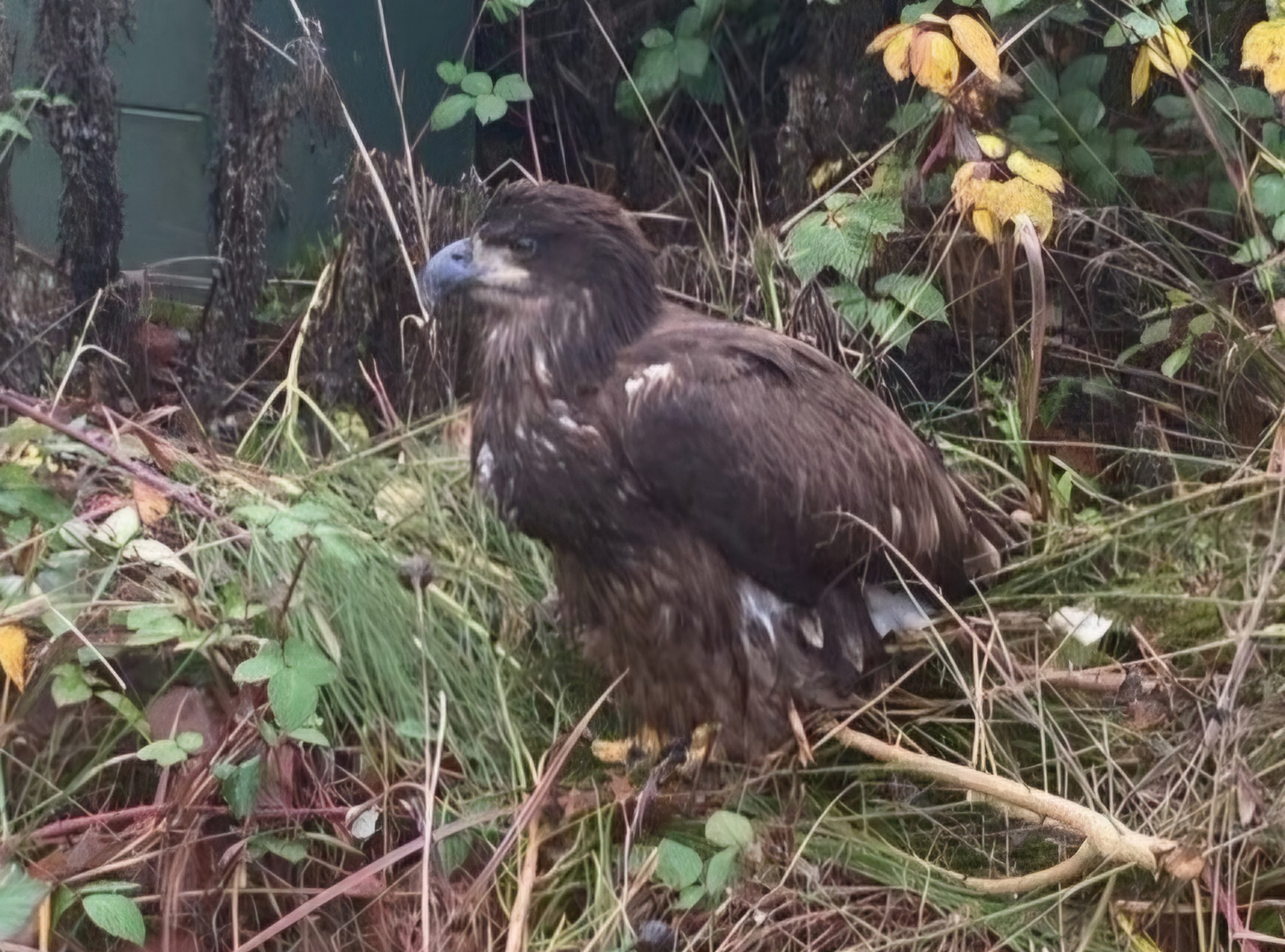
Anna Leon and Ryan Nadel set a funnel for monitoring population levels of Douglas-fir bark beetles and ambrosia beetles. Early detection of population surges is key to stemming outbreaks.
In mid-May, three scientists from our Centralia, Washington, forestry research center — John Browning, Anna Leon and Ryan Nadel — spent several days in fire-damaged tree stands on our Oregon Timberlands. John, Anna and Ryan specialize in forest health and were teaching our crews in the woods to identify two pest insects that thrive in disturbed forests.
“We’re particularly concerned about two types of beetles,” says Anna, a forest pathology scientist. “One is the ambrosia beetle, which attacks dead or stressed trees. The other is the Douglas-fir beetle, which prefers stressed trees but also attacks healthy trees, especially when populations reach epidemic levels.”
Our Forest Health team in Centralia is responsible for assessing risks and developing strategies to deal with threats associated with forest insects and disease across all our timberlands. Doing so requires prompt identification and reporting of pest sightings, and — when combined with other available information — these reports allow us to determine the best plan of action to mitigate issues.
This internal monitoring system has been in place for several years, but the team has recently introduced a new reporting app to streamline and sharpen the process.
“The app was designed and implemented late last year to facilitate forest health reporting,” says Ryan, a silviculture scientist who joined Weyerhaeuser from Auburn University earlier this year. “We adopted it as a repository for tracking pest outbreaks in response to the fires.”
MAPPING OUTBREAKS
Anna and John started analyzing the potential for outbreaks while the Oregon wildfires were still smoldering this past fall. They informed Western Timberlands about the risk associated with insect outbreaks in the areas impacted by the fires to be sure leaders, planners, harvest managers and others would be fully prepared.
They recommended establishing a well-designed sampling protocol that would allow Western Timberlands to understand the dynamics of the insect populations of interest and assess the risks associated with them. Miranda Fix, a forest statistician, integrated available forest information and fire damage assessments into the protocol, and in the spring 102 traps were spread throughout our four fire-damaged tree farms in Oregon.
“We’re also augmenting data from the app and the traps with strategically dispersed pheromone-baited monitoring,” John says.
Pheromones are chemical substances that insects and other animals release to communicate with each other by smell. In this case, the bait is an aggregating pheromone that attracts the specific insect of interest, and the traps are carefully designed and strategically located to better understand population potential.
“We dilute the pheromone because we want to get population counts without unintentionally attracting beetles to an area that’s not heavily infested,” John says. “The beetles are typically lazy flyers that prefer not to travel long distances, and we don’t want to give them an incentive to break out of that pattern.”
The Douglas-fir bark beetle. It borrows into a tree’s phloem, disrupting the flow of nutrients. In severe outbreaks it can infect healthy trees, although it prefers stressed and damaged trees.
SALVAGE IS THE BEST MITIGATION
At their peak in May and June, overwintering and newly emerged adult beetles seek new habitats, using highly adapted olfactory sensors on their antennae to detect compounds emitted by stressed and decomposing trees, including acetone, ethanol and various terpenes. Once the adult beetles smell a suitable tree, they attack.
Ambrosia beetles bore into the wood to lay eggs, creating channels and dark stains. Douglas-fir beetles, on the other hand, nestle into the phloem — the system just beneath the bark that transports nutrients made in the leaves to all other parts of the tree — and disrupt its flow. This activity eventually kills the tree, and the beetles then move to nearby stands — including green stands.
The only effective method for mitigating an outbreak of either beetle species is to salvage fire-damaged or fire-stressed wood as soon as possible, so pinpointing the location of outbreaks gives our salvage crews a crucial chance to stem the spread of an outbreak.
“We expect our various monitoring methods will give our timberlands teams timely information they can utilize to adjust harvest plans accordingly,” Anna says. “For the Douglas-fir beetle, this might include harvesting at-risk stands to create a buffer zone.”
SHARING DATA BEYOND OUR PROPERTY LINES
“An outbreak anywhere is an outbreak everywhere,” Anna says. “We’re committed to working with adjacent landowners, both public and private.”
The Forest Health team works closely with the Oregon Department of Forestry and the U.S. Forest Service, sharing information about outbreaks and evaluating other mitigation options. For now, current methods are working.
“We’ll continue to monitor so Timberlands can move salvage crews to infested areas for prompt harvesting and buffering,” Anna says. “We knew the fires would present these types of challenges. Now, it’s a race against time to stay ahead of the beetles.”


